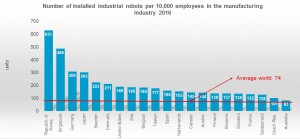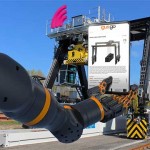Robot density rises globally, reports IFR
The automation of production is accelerating around the world: 74 robot units per 10,000 employees is the new average of global robot density in the manufacturing industries, up from 66 in 2015. By regions, the average robot density in Europe is 99 units, in the Americas 84 and in Asia 63 units. But the UK is lagging well behind the rest of Europe – and indeed much of the rest of the world – ranking at 22 with a robot population of 71 units per 10,000 employees.
 Pictured (click on the image to see the full size graphic): Countries with industrial robot installations below the world average.
Pictured (click on the image to see the full size graphic): Countries with industrial robot installations below the world average.
The top 10 most automated countries in the world are: South Korea, Singapore, Germany, Japan, Sweden, Denmark, USA, Italy, Belgium and Taiwan. This is according to the 2017 World Robot Statistics, issued by the International Federation of Robotics (IFR).
“Robot density is an excellent standard for comparison in order to take into account the differences in the automation degree of the manufacturing industry in various countries,” says Junji Tsuda, president of the International Federation of Robotics. “As a result of the high volume of robot installations in Asia in recent years, the region has the highest growth rate. Between 2010 and 2016, the average annual growth rate of robot density in Asia was 9%, in the Americas 7% and in Europe 5%.”
Growth across Europe, but UK falling behind
Europe’s most automated country is Germany – ranking third worldwide with 309 units. The annual supply and the operational stock of industrial robots in 2016 had a share of 36% and 41% respectively of total robot sales in Europe. Between 2018 and 2020, the annual supply in Germany will continue to grow by at least 5% on average per year due to the increasing demand for robots in the general industry and in the automotive industry.
The general industry in the UK is highly in need of necessary investment in order to modernise and increase productivity. The low robot density rate is indicative of this fact
France has a robot density of 132 units (ranking 18th in the world), which is well above the global average of 74 robots – but relatively weak compared to other EU countries. EU members like Sweden (223 units), Denmark (211 units), Italy (185 units) and Spain (160 units) enjoy a much higher degree of automation using industrial robots in the manufacturing segment. But under the new government, France is in the process of regaining competitiveness in its manufacturing sectors. This may, to a certain extent, promote installations of new robots in the next few years. In 2017, the number of robot installations in France is expected to increase by about 10%. Between 2018 and 2020, an average annual growth rate between 5 and 10% is likely.
The UK has a robot density below the world average of 74 units with 71 units, ranking 22nd. The general industry is highly in need of necessary investment in order to modernise and increase productivity. The low robot density rate is indicative of this fact. Despite the decision to leave the EU, there are currently many suggested investment plans for capacity expansion and modernisation of foreign and local automotive companies. It is not evident though whether companies will hold back investments due to uncertainties concerning customs duties.
The eastern European countries Slovenia (137 units, ranking 16th in the world) and Slovakia (135 units, ranking 17th worldwide), both have a robot density that is above Switzerland’s (128 units, ranking 19th in the world). The Czech Republic is ranking 20th on the global scale with 101 units. Robot supplies in the Czech Republic and Slovakia mainly depend on the automotive industry’s demand. Slovenia is the most successful among the Balkan countries with 60% of the total robot supply used mainly for the automotive industry (387 units, 33% more than in 2015).
Dynamic development in China
The development of robot density in China was the most dynamic in the world. Due to the significant growth of robot installations, particularly between 2013 and 2016, the density rate rose from 25 units in 2013 to 68 units in 2016. Today, China’s robot density ranks 23rd worldwide. And the government intends to forge ahead and make it into the world’s top 10 most intensively automated nations by 2020. By then, its robot density is targeted to rise to 150 units. Furthermore, the aim is to sell a total of 100,000 domestically produced industrial robots by 2020 (2017: 27,000 units from Chinese robot suppliers, 60,000 from foreign robot suppliers).
Pictured (click on the image to see the full size graphic): Nations with industrial robot populations above the world average.
Worldwide, the Republic of Korea has by far the highest robot density in the manufacturing industry – a position the country has held since 2010. The country’s robot density exceeds the global average by a good eight-fold (631 units). This high growth rate is the result of continued installations of a high volume of robots particularly in the electrical/electronics industry and in the automotive industry.
Singapore follows in second place with a rate of 488 robots per 10,000 employees in 2016. About 90% of robots in Singapore are installed in the electronics industry.
Japan ranked fourth in the world: in 2016, 303 robots were installed per 10,000 employees in the manufacturing industry – following Germany ranking 3rd (309 units). Japan is the world’s predominant industrial robot manufacturer: the production capacity of Japanese suppliers reached 153,000 units in 2016 – the highest level ever recorded. Today, Japan’s manufacturers deliver 52% of the global supply.
Modernisation of production in North America
Robot density in the United States increased significantly to 189 robots in 2016 – the country ranks seventh in the world. Since 2010, the necessary modernisation of domestic production facilities has boosted robot sales in the United States. The main driver of this growth was the ongoing trend to automate production in order to strengthen American industries on the global market and to keep manufacturing at home, and in some cases, to bring back manufacturing that had previously been sent overseas.
The automotive industry still leads as the main customer of industrial robots with about 52% of total sales in 2016. Robot sales in the United States will continue to increase between 2017 and 2020 by at least 15% on average per year.
Robot density in Canada has been on the rise and reached 145 units in 2016 (ranking 13th worldwide). Growth was mainly driven by installations in the automotive industry.
Mexico is predominantly a production hub for car manufacturers and automotive parts suppliers that export to the United States and increasingly to South America. The automotive industry in Mexico is by far the main robot customer with a share of 81 percent in 2016. Robot density is at 33 units, which is still far below the world average of 74 units, ranking 31st on the global scale.
Visit the IFR website for more information















